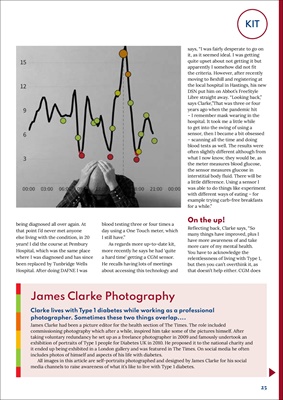
25
KIT
being diagnosed all over again. At
that point I'd never met anyone
else living with the condition, in 20
years! I did the course at Pembury
Hospital, which was the same place
where I was diagnosed and has since
been replaced by Tunbridge Wells
Hospital. After doing DAFNE I was
blood testing three or four times a
day using a One Touch meter, which
I still have."
As regards more up-to-date kit,
more recently he says he had 'quite
a hard time' getting a CGM sensor.
He recalls having lots of meetings
about accessing this technology and
says, "I was fairly desperate to go on
it, as it seemed ideal. I was getting
quite upset about not getting it but
apparently I somehow did not fit
the criteria. However, after recently
moving to Bexhill and registering at
the local hospital in Hastings, his new
DSN put him on Abbot's FreeStyle
Libre straight away. "Looking back,"
says Clarke,"That was three or four
years ago when the pandemic hit
- I remember mask wearing in the
hospital. It took me a little while
to get into the swing of using a
sensor, then I became a bit obsessed
- scanning all the time and doing
blood tests as well. The results were
often slightly different although from
what I now know, they would be, as
the meter measures blood glucose,
the sensor measures glucose in
interstitial body fluid. There will be
a little difference. Using a sensor I
was able to do things like experiment
James Clarke Photography
Clarke lives with Type 1 diabetes while working as a professional
photographer. Sometimes these two things overlap....
James Clarke had been a picture editor for the health section of The Times. The role included
commissioning photography which after a while, inspired him take some of the pictures himself. After
taking voluntary redundancy he set up as a freelance photographer in 2009 and famously undertook an
exhibition of portraits of Type 1 people for Diabetes UK in 2010. He proposed it to the national charity and
it ended up being exhibited in a London gallery and was featured in The Times. On social media he often
includes photos of himself and aspects of his life with diabetes.
with different ways of eating - for
example trying carb-free breakfasts
for a while."
On the up!
Reflecting back, Clarke says, "So
many things have improved, plus I
have more awareness of and take
more care of my mental health.
You have to acknowledge the
relentlessness of living with Type 1,
but then you can't overthink it, as
that doesn't help either. CGM does
help - it offers a bit more security,
however it's stressful when it does
not work properly, when you can't
find your reader or your phone with
your app on it."
He also acknowledges that
sometimes people can be
thoughtless. He remembers,
"Unhelpfully, when I was first
diagnosed, someone told me that
it would knock a third off of my
expected lifespan. I was told it was
the equivalent toll on your body
as being an alcoholic that chained
smoked. I stopped smoking straight
away on hearing that, but comments
like that are worrisome, an added
burden I would say."
Clarke is 58 now, is happily
married with two teenage kids and
two dogs. He walks for miles over a